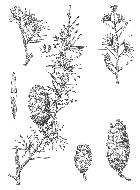
Line drawing; for full size image go to the Flora of China (Wu and Raven 1999).
Nothotsuga longibracteata
Bristlecone hemlock (Farjon 1990), 长苞铁杉 chang bao tie shan [Chinese] (Wu and Raven 1999).
The sole species in Nothotsuga Hu ex C.N. Page 1988. Syn: Tsugo-Keteleeria Van Campo-Duplan et Gaussen (1948), nom. illeg.; Nothotsuga Hu, nom. nud. (Farjon 1990).
Syn: Tsuga longibracteata W.C. Cheng 1932; Tsugo-Keteleeria longibracteata (Cheng) Van Campo-Duplan et Gaussen; Nothotsuga longibracteata (Cheng) Hu, nom. nud.; Hesperopeuce longibracteata (Cheng) Cheng, pro syn. (Farjon 1990).
This species differs strikingly from species of Tsuga as follows: leaves radially spreading, stomatal lines present on each surface; pollen cones clustered in umbels from a single lateral bud; seed cones ± erect; bracts included except for slightly exserted, apical cusp. The name Tsugo-keteleeria Van Campo & Gaussen, described as a hybrid between Tsuga and Keteleeria, is invalid (ICBN, Art. 32.1(b) and H.6.2), as is the combination Tsugo-keteleeria longibracteata (W. C. Cheng) Van Campo & Gaussen (Wu and Raven 1999).
Trees to 30 m tall and 100 cm dbh. Bark dark brown, longitudinally fissured. Branchlets drying brownish yellow or reddish brown, aging brown-gray or dark brown, glabrous. Leaves with petiole 1-1.5 mm; blade 11-20(-24) × 1-2(-2.5) mm, smooth or faintly grooved, stomatal lines 7-12 adaxially, 10-16 along each surface abaxially, apex acute to slightly obtuse. Seed cones purplish or red, maturing to dark brown, 2-5.8 × 1.2-2.5 cm, persisting several years, then breaking off whole or sometimes disintegrating. Seed scales at middle of cones broadly rhombic or suborbicular, 0.9-2.2 × 1.2-2.5 cm, base peltate-auriculate, apex truncate-rounded. Bracts subspatulate, 0.7-1.8 cm, apical cusp acute or acuminate. Seeds triangular-ovoid, 4-8 × 2.5-3 mm; wing ovate-oblong, apex rounded. Pollination March-April, seed maturity October (Wu and Raven 1999).
China: NE Guizhou, SW Hunan, N Guangdong, NE Guangxi & S Fujian (Farjon 1990). Hardy to Zone 8 (cold hardiness limit between -12.1°C and -6.7°C) (Bannister and Neuner 2001).
Forming small, pure stands, or in evergreen, broad-leaved, sclerophyllous forests (species of Castanopsis, Lithocarpus, and Quercus), or mixed, mesophytic forests (Fagus longipetiolata, Pinus kwangtungensis, Tetracentron sinensis, etc.) on steep, sunny mountain slopes and ridges on acidic soils in areas with cool, temperate, humid climate and abundant rainfall and fog; (300-)400-1900(-2300) m. C and S Fujian, N Guangdong, C and N Guangxi, E Guizhou, S Hunan, S Jiangxi (Wu and Raven 1999).
An ideal tree for afforestation in mountains above middle elevations in subtropical regions. The timber is used for construction and furniture (Wu and Raven 1999).
This is a vulnerable species; few trees survive in most populations because of large scale logging (Wu and Raven 1999).
Farjon, Aljos. 1990. Pinaceae: drawings and descriptions of the genera Abies, Cedrus, Pseudolarix, Keteleeria, Nothotsuga, Tsuga, Cathaya, Pseudotsuga, Larix and Picea. Königstein: Koeltz Scientific Books.
The species account at Threatened Conifers of the World.
Last Modified 2023-02-26